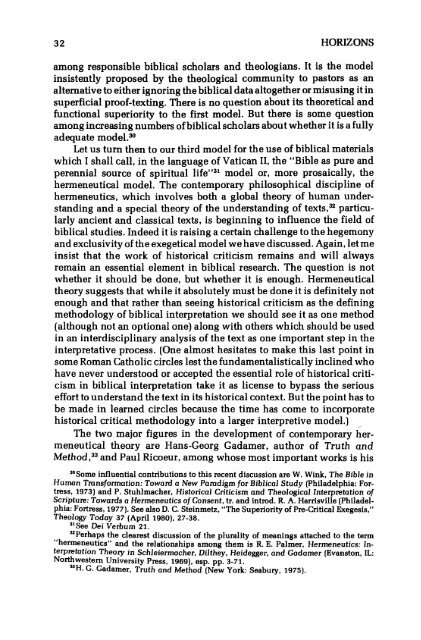FROM EXEGESIS TO HERMENEUTICS - Rice School of Pastoral ...
FROM EXEGESIS TO HERMENEUTICS - Rice School of Pastoral ...
FROM EXEGESIS TO HERMENEUTICS - Rice School of Pastoral ...
Create successful ePaper yourself
Turn your PDF publications into a flip-book with our unique Google optimized e-Paper software.
32 HORIZONSamong responsible biblical scholars and theologians. It is the modelinsistently proposed by the theological community to pastors as analternative to either ignoring the biblical data altogether or misusing it insuperficial pro<strong>of</strong>-texting. There is no question about its theoretical andfunctional superiority to the first model. But there is some questionamong increasing numbers <strong>of</strong> biblical scholars about whether it is a fullyadequate model. 30Let us turn then to our third model for the use <strong>of</strong> biblical materialswhich I shall call, in the language <strong>of</strong> Vatican II, the "Bible as pure andperennial source <strong>of</strong> spiritual life" 31model or, more prosaically, thehermeneutical model. The contemporary philosophical discipline <strong>of</strong>hermeneutics, which involves both a global theory <strong>of</strong> human understandingand a special theory <strong>of</strong> the understanding <strong>of</strong> texts, 32particularlyancient and classical texts, is beginning to influence the field <strong>of</strong>biblical studies. Indeed it is raising a certain challenge to the hegemonyand exclusivity <strong>of</strong> the exegetical model we have discussed. Again, let meinsist that the work <strong>of</strong> historical criticism remains and will alwaysremain an essential element in biblical research. The question is notwhether it should be done, but whether it is enough. Hermeneuticaltheory suggests that while it absolutely must be done it is definitely notenough and that rather than seeing historical criticism as the definingmethodology <strong>of</strong> biblical interpretation we should see it as one method(although not an optional one) along with others which should be usedin an interdisciplinary analysis <strong>of</strong> the text as one important step in theinterpretative process. (One almost hesitates to make this last point insome Roman Catholic circles lest the fundamentalistically inclined whohave never understood or accepted the essential role <strong>of</strong> historical criticismin biblical interpretation take it as license to bypass the seriouseffort to understand the text in its historical context. But the point has tobe made in learned circles because the time has come to incorporatehistorical critical methodology into a larger interpretive model.)The two major figures in the development <strong>of</strong> contemporary hermeneuticaltheory are Hans-Georg Gadamer, author <strong>of</strong> Truth andMethod, 33 and Paul Ricoeur, among whose most important works is his30Some influential contributions to this recent discussion are W. Wink, The Bible inHuman Transformation: Toward a New Paradigm for Biblical Study (Philadelphia: Fortress,1973) and P. Stuhlmacher, Historical Criticism and Theological interpretation <strong>of</strong>Scripture: Towards a Hermeneutics <strong>of</strong> Consent, tr. and introd. R. A. Harrisville (Philadelphia:Fortress, 1977). See also D. C. Steinmetz, "The Superiority <strong>of</strong> Pre-Critical Exegesis,"Theology Today 37 (April 1980), 27-38.31See Dei Verbum 21.32Perhaps the clearest discussion <strong>of</strong> the plurality <strong>of</strong> meanings attached to the term"hermeneutics" and the relationships among them is R. E. Palmer, Hermeneutics: interpretationTheory in Schleiermacher, Dilthey, Heidegger, and Gadamer (Evanston, IL:Northwestern University Press, 1969), esp. pp. 3-71.ωΗ. G. Gadamer, Truth and Method (New York: Seabury, 1975).



